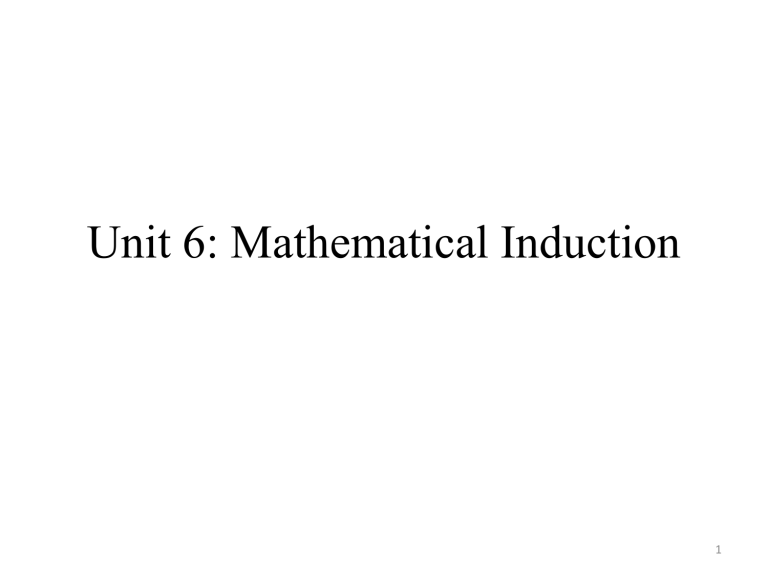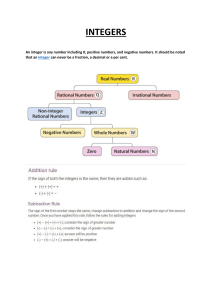
Unit 6: Mathematical Induction 1 Subunit 6(a): Ordinary Induction 2 Principle of Mathematical Induction (Ordinary) Let 𝑃(𝑛)be a statement about the positive integer 𝑛. To prove that 𝑃 𝑛 is true for all positive integers 𝑛, it is sufficient to do the following: • (Basic step): Prove that 𝑃(1) is true • (Inductive step): Prove that for every positive integer 𝑘, 𝑃(𝑘) → 𝑃(𝑘 + 1). If we succeed in doing these two things, it follows that 𝑃(𝑛) is true for all positive integers 𝑛. 3 Example 1 𝑛(𝑛+1) 2 • Prove that 1 + 2 + ⋯ + 𝑛 = for every positive integer 𝑛. Solution: Let the given statement be 𝑃(𝑛). Basic step: 𝑃(1) says that 1 = 1(1+1) 2 which is true. Inductive step: Let 𝑘 be any positive integer. We have to show that 𝑃(𝑘) → 𝑃(𝑘 + 1). Suppose that 𝑃 𝑘 is true. This means that 4 Example 1 (continued) 1 + 2 + ⋯+ 𝑘 = 𝑘(𝑘+1) . 2 Then, k (k + 1) + k +1 2 k = (k + 1) + 1 2 (k + 1)(k + 2) = 2 1 + 2 + k + (k + 1) = which is 𝑃(𝑘 + 1). We have shown that 𝑃(𝑘) → 𝑃(𝑘 + 1) for every positive integer 𝑘. It follows that 𝑃(𝑛) is true for every positive integer 𝑛 by the principle of mathematical induction. 5 Principle of Mathematical Induction (modified) Let 𝑃(𝑛) be a statement about the integer 𝑛 and let 𝑏 be a fixed integer. To prove that 𝑃(𝑛) is true for every integer 𝑛 with 𝑛 ≥ 𝑏, it is sufficient to do the following: • (Basic step): Prove that 𝑃(𝑏) is true. • (Inductive step): Prove that for every integer 𝑘 with 𝑘 ≥ 𝑏, we have 𝑃(𝑘) → 𝑃(𝑘 + 1). It will follow that 𝑃(𝑛) is true for all integers 𝑛 with 𝑛 ≥ 𝑏. 6 Example 2 Prove that 2𝑛 < 𝑛! for every integer 𝑛 with 𝑛 ≥ 4. Solution: Let the given statement be 𝑃(𝑛). • Basic step: 𝑃(4) says that 24 < 4! which is true. • Inductive step: Let 𝑘 be a positive integer with 𝑘 ≥ 4. We have to show that 𝑃 𝑘 → 𝑃 𝑘 + 1 . Suppose that 𝑃(𝑘) is true. 7 Example 2 (continued) Thus, 2𝑘 < 𝑘!. Multiplying both sides by 2 gives 2𝑘+1 < 2 𝑘! . Next, note that 2 < 𝑘 + 1 since 𝑘 ≥ 4. Therefore, 2 𝑘! < 𝑘 + 1 𝑘! . Thus, 2𝑘+1 < 𝑘 + 1 !. We have shown that 𝑃(𝑘) → 𝑃(𝑘 + 1)for every integer 𝑘 with 𝑘 ≥ 4. It follows that 𝑃(𝑛) is true for every integer 𝑛 with 𝑛 ≥ 4. 8 Divisibility Let 𝑎 and 𝑏 be integers with 𝑎 ≠ 0. We say that 𝑎 divides 𝑏 and write 𝑎|𝑏 provided that there exists an integer 𝑐 such that 𝑏 = 𝑎𝑐. Whenever 𝑎|𝑏, we also say the following • 𝑎 is a factor of 𝑏 • 𝑏 is a multiple of 𝑎 • 𝑏 is divisible by 𝑎 • 𝑎 is a divisor of 𝑏. If 𝑎 does not divide 𝑏, we write a |⁄b For example, 3|6 but 2 |⁄ 5. 9 Example 3 • Prove that 7|(32𝑛+1 + 2𝑛+2 ) for all nonnegative integers 𝑛. Solution: Let the given statement be 𝑃(𝑛). 𝑃(0) says that 7|(31 +22 ) which is true. Next, let 𝑘 be a non-negative integer such that 𝑃(𝑘) is true. Hence, 7|(32𝑘+1 + 2𝑘+2 ) so that there is an integer 𝑞 with 32𝑘+1 + 2𝑘+2 = 7𝑞. Thus, 32𝑘+1 = 7𝑞 − 2𝑘+2 (1) 10 Example 3 (continued) Note that 32 ( k +1) +1 + 2( k +1) + 2 = 32 k +3 + 2 k +3 = 3232 k +1 + 2 k +3 = 9(7q − 2 k + 2 ) + 2 k +3 = 7(9q) − 9(2 k + 2 ) + 2(2 k + 2 ) = 7(9q) − 7(2 k + 2 ) = 7(9q − 2 k + 2 ) Thus, 7 | (32 ( k +1) +1 + 2( k +1) + 2 ) since 9q − 2 k + 2 is an integer. We have shown that P(k ) → P(k + 1) for every non - negative integer k . Hence, P(n) is true for all non - negative integers n. 11 Subunit 6(b): Strong Induction 12 Example 4 • The Fibonacci sequence is defined recursively as follows: 𝑓0 = 0, 𝑓1 = 1, 𝑓𝑛 = 𝑓𝑛−1 + 𝑓𝑛−2 for all integers 𝑛 with 𝑛 ≥ 2. The first few terms are 0, 1, 1, 2, 3, 5, 8, 13. Prove that 𝑓𝑛 = 1 1+ 5 5 2 𝑛 − 1 1− 5 5 2 𝑛 for every non- negative integer 𝑛. 13 Example 4 (continued) Solution: Let 𝑃(𝑛) be the statement that has to 1+ 5 2 2 1− 5 . 2 be proved. Let 𝛼 = 𝑎𝑛𝑑 𝛽 = Note that 𝛼 2 = 𝛼 + 1 and 𝛽 = 𝛽 + 1. Also, note that 1 𝑛 1 𝑛 𝑃(𝑛) says that 𝑓𝑛 = 𝛼 − 𝛽 . 5 5 Basic Step: It is easily checked that 𝑃(0) and 𝑃(1) are true. 14 Example 4 (continued) • Inductive step: Let 𝑘 be an integer with 𝑘 ≥ 2. We will show that if 𝑃 𝑗 is true for every integer 𝑗 with 0 ≤ 𝑗 < 𝑘 then 𝑃(𝑘) must be true. So, suppose that 𝑃(𝑗) is true for every integer 𝑗 with 0 ≤ 𝑗 < 𝑘. This means that 𝑃(𝑘 − 2) and 𝑃(𝑘 − 1) are true. Hence, 𝑓𝑘−2 = 𝑓𝑘−1 = 1 𝑘−2 1 𝑘−2 𝛼 − 𝛽 and 5 5 1 𝑘−1 1 𝑘−1 𝛼 − 𝛽 . 5 5 15 Example 4 (continued) We have f k = f k −1 + f k − 2 = = = = = 1 k −1 1 k −1 1 k − 2 1 k − 2 − + − 5 5 5 5 1 1 k −1 + k − 2 − k −1 + k − 2 5 5 1 k −2 1 k −2 ( + 1) − ( + 1) 5 5 1 k −2 2 1 k −2 2 − (since 2 = + 1 and 2 = + 1) 5 5 1 k 1 k − 5 5 ( ) ( ) 16 Example 4 (continued) We have shown that for every integer 𝑘 with 𝑘 ≥ 2, if 𝑃(𝑗) is true for every integer 𝑗 with 0 ≤ 𝑗 < 𝑘 then 𝑃(𝑘) is true. Together with the basic step where it was shown that 𝑃(0)and 𝑃(1) are true, it follows that 𝑃(𝑛) is true for every nonnegative integer 𝑛 by the principle of strong induction. 17 Example 5 Consider the sequence defined recursively as follows: 𝑎1 = 1, 𝑎2 = 2, 𝑎3 = 3, and 𝑎𝑛 = 𝑎𝑛−1 + 𝑎𝑛−2 + 𝑎𝑛−3 for all integers 𝑛 with 𝑛 ≥ 4. Prove that 𝑎𝑛 < 2𝑛 for all positive integers 𝑛. Solution: Let 𝑃(𝑛) be the statement that has to be proved. Basic step: It is easily seen that 𝑃 1 , 𝑃(2) and 𝑃(3) are true. 18 Example 5 (continued) • Inductive step: Let 𝑘 be an integer with 𝑘 ≥ 4. Suppose that 𝑃 𝑗 is true for every integer 𝑗 with 1 ≤ 𝑗 < 𝑘. We will show that 𝑃(𝑘) is true. Note that by our assumption, 𝑃(𝑘 − 3), 𝑃(𝑘 − 2)and 𝑃(𝑘 − 1) are all true. Hence, 𝑎𝑘−3 < 2𝑘−3 , 𝑎𝑘−2 < 2𝑘−2 and 𝑎𝑘−1 < 2𝑘−1 . Hence, we have 19 Example 5 (continued) ak = ak −1 + ak − 2 + ak −3 2 k −1 + 2 k − 2 + 2 k −3 = 2 k −3 (2 2 + 2 + 1) = 2 k −3 (7) 2 k −3 (8) = 2 k . We have shown that for every integer k with k 4, if P( j ) is true for every integer j with 1 j k then P(k ) is true. Together with the fact that P(1), P(2), and P(3) are true, it follows that P(n) is true for all positive integers n. 20



